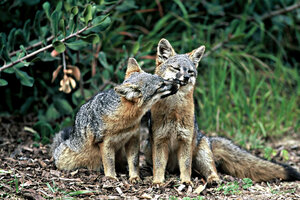Endangered no more: California's island foxes make a surprising rebound
The island-dwelling gray fox was once easy prey for California's golden eagles, but extensive conservation efforts appear to have staved off extinction.

This undated photo provided by the US. Fish and Wildlife Service shows two island foxes in Channel Islands National Park, Calif. Three fox subspecies native to California's Channel Islands were removed from the list of endangered species on Thursday, Aug. 11, 2016, in what federal officials have called the fastest recovery of any mammal listed under the Endangered Species Act.
Chuck Graham/U.S. Fish and Wildlife Service/AP
Three subspecies of California’s Channel Island fox will live to populate their island homes after extensive conservation efforts by the US government.
The Channel fox population on four islands – Santa Cruz, Santa Rosa, San Miguel, and Santa Catalina – declined dramatically in the 1990s, about a century after settlers first brought pigs to the islands: a move that attracted golden eagles, who found the foxes tasty, as well.
Thanks to sustained efforts, from breeding foxes in captivity to removing natural predators, three of the fox's subspecies were removed from the federal list of endangered species, which the Department of the Interior calls the fastest-ever rescue.
“The Island Fox recovery is an incredible success story about the power of partnerships,” US Interior Secretary Sally Jewell said in a press release, “and the ability of collaborative conservation to correct course for a species on the brink of extinction.”
A canine distemper epidemic and the predatory habits of local golden eagle populations caused Santa Rosa’s fox population to drop from 1,780 to 15, and 450 to 15 on San Miguel. In 2004, the foxes were given a 50 percent chance of going extinct within the next decade, according to the press release.
After the subspecies were listed on the List of Endangered and Threatened Wildlife under the Endangered Species Act (ESA), more than 300 experts and groups, including the National Park Service and the Nature Conservancy, came together to help.
Physically similar to the mainland gray fox, island foxes likely arrived on the islands thousands of years ago. They thrived in their new homes when they first arrived because of the abundance of prey, including such delicacies as lizards and mice.
When humans arrived, however, the outlook for the foxes darkened. Escaped pigs from 19th-century homesteads attracted hungry eagles to the islands. Although the eagles were initially tracking the swine, they also began to prey on the gray fox population, according to The Washington Post.
The foxes have a "naive, adorable little personality," Christina Boser, a fox ecologist with the Nature Conservancy, told the Post. That enhances their fluffy, cuddly image, but makes them easy prey for predators.
In order to boost the population, conservationists went to extreme measures. They relocated reluctant golden eagles, bred the foxes in captivity, removed the feral pigs, and brought back bald eagles, whose absence had allowed the more rapacious golden eagle to feast on the foxes.
Today, there are around 700 foxes on San Miguel Island, which had just 15 in 2004. Santa Rosa now has a population of about 1,200, and Santa Cruz about 2,100.
Conservationists say that the fox’s recovery will serve as a model for future efforts.
"Many aspects of this recovery effort – from its scientific rigor to the collaborative enterprise that drove it – can serve as model [sic] to advance conservation elsewhere," Scott Morrison, the director of Conservation Science at the Nature Conservancy, said in a press release.
Now, the species will be officially de-listed from the Endangered Species List: the 37th species to make it off.
"The Endangered Species Act is an effective tool to protect imperiled wildlife so future generations benefit from the same abundance and diversity of animals and plants we enjoy today," said Secretary Jewell. "What happened in record time at Channel Islands National Park can serve as a model for partnership-driven conservation efforts across the country."

